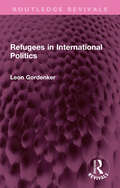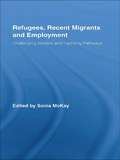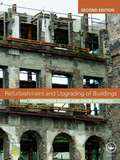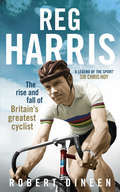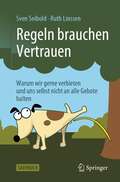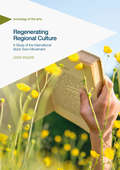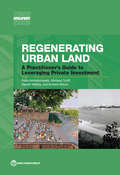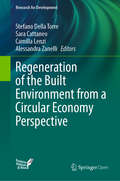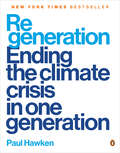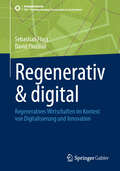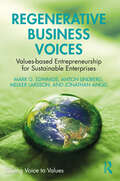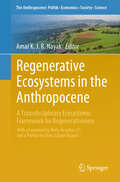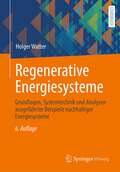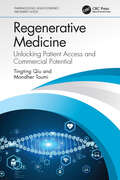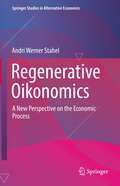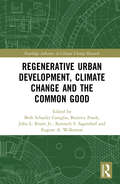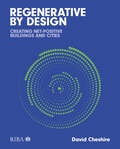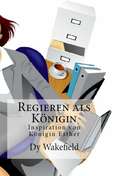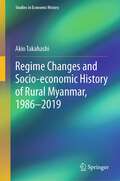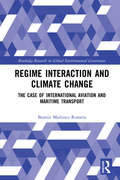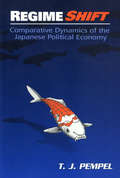- Table View
- List View
Refugees in International Politics (Routledge Revivals)
by Leon GordenkerOriginally published in 1987, Refugees in International Politics explores the nature of forced migration. It sets out systematically the factors that set refugees in motion and explains how and why a flexible network of organizations copes with the inescapable results of their presence. It suggests measures to reduce both the human suffering involved in forced migration and the disturbing effects of international relations.
Refugees, Recent Migrants and Employment: Challenging Barriers and Exploring Pathways (Routledge Research in Population and Migration)
by Sonia McKayUpheavals in vast areas of the world have led to a growing number of international refugees, a significant proportion of which have made their way to the West. At the same time, economic and social pressures, together with skills and labour shortages, have encouraged the migration for work of millions of workers worldwide. Although there has been a constant media focus on these two groups, little is known about their labour market experiences. This collection examines the problems faced by refugees and recent migrants in accessing employment as well as the policy frameworks that address the labour market rights of refugees and economic migrants.
Refurbishment and Upgrading of Buildings
by David Highfield Christopher GorseA detailed guide to the technical aspects of refurbishing and upgrading buildings, this book provides solutions to a range of problems, challenges and issues and is essential reading for all students studying building refurbishment at all levels. Includes: existing floor and wall strengthening facade retention introduction of new floors timber decay problems fire-resistance prevention of moisture and damp upgrading thermal and acoustic performance. This new edition has been fully updated to include new technological information, and covers new areas such as stonework restoration and repair, upgrading of c1960 framed buildings, refurbishment logistics and case-studies.
Refuse to Lose: Persistence Pays
by Jeffrey PfefferThis chapter provides examples of why determination and resilience, for either a company or an individual, should not be overlooked as important factors in producing successful business outcomes.
Reg Harris: The rise and fall of Britain's greatest cyclist
by Robert DineenReg Harris, whose statue overlooks the Manchester Velodrome, is the legend who all track cyclists want to emulate. He was a poor, working-class boy born in the Depression who escaped the Lancashire mills to utterly dominate his sport. He triumphed as world champion an incrediblefive times between 1947 and 1954 and performed medal-winning heroics at the London Olympics.At his peak he was the most adored sportsman in the country attracting huge crowds, sponsorship, and the company of the rich and famous. But, fiercely driven and ruthlessly single-minded, Harris had a dark side. His was a sensational life fuelled by an insatiable need for money, celebrity, fast cars and beautiful women that constantly threatened to destroy him. Following an exhaustive investigation, Robert Dineen has uncovered an epic sporting rise and fall – a story more astounding than anyone had known.
RegTech: A New Way to Manage Risks
by Jonas Heese James Barnett Aiyesha DeyA note on regulatory technology (RegTech) describing its evolution, use cases, and the competitive environment in 2021.
Regarding NAFTA
by Debora L. Spar Elizabeth B. SteinIn the aftermath of World War II, the countries of the industrialized world engaged in an unprecedented round of institution-building, through which historical barriers to international trade, especially tariffs, came tumbling down. The GATT has reshaped the environment of world trade to such an extent that international trade flows have exploded. Even as global trade has become more integrated, however, a second round of institutions, regional rather than global, has emerged. The most recent and largest of the major regional institutions, NAFTA, was signed on December 17, 1992, and took effect in early 1994. This case examines the effect of this radically new institutional context on three different firms, each representing a different industry and country.
Regeln brauchen Vertrauen: Warum wir gerne verbieten und uns selbst nicht an alle Gebote halten
by Ruth Linssen Sven SeiboldMenschen brauchen Regeln und Menschen rebellieren gegen Regeln. Regeln geben uns Sicherheit und zugleich schränken sie uns ein. Gegen manche Regeln leisten Menschen aktiv Widerstand oder unterlaufen sie heimlich – mit Negativfolgen für alle. Das Sachbuch zeigt, wie man klug mit Regeln und mit Regelbrechern umgeht. Sie erkennen, warum viele Menschen Regeln einhalten und manche Menschen Regeln brechen. Und warum Vertrauen tatsächlich besser ist als Kontrolle. Aus dem Inhalt: Warum man Regeln braucht, warum sich manche Menschen an Regeln halten und andere nicht, welche Regeln wirksam sind, warum Vorbilder unersetzbar sind, wie man Gutwillige bei der Stange hält, wie man mit Regelbrüchen umgeht, wie man böse Fallen vermeidet. Über die Autor:innen: Sven Seibold ist Psychologe und Professor für Wirtschaftspsychologie. Er berät Unternehmen in Fällen von Mobbing, Burn-out, Wirtschaftskriminalität und Wirtschaftsspionage. Ruth Linssen ist Professorin für Soziologie und Recht an der Fachhochschule Münster. Sie berät und schult Behörden und Unternehmen zu den Themen Compliance und Korruptionsprävention.
Regency Plaza
by William J. Poorvu Richard E. CrumDesigned to examine the process of project management during the development cycle of a luxury condominium building, exploring the issue of how the design, development strategy, project organization, and project personnel are interrelated. More specifically, looks at how these factors shape the day-to-day operations of a development and how they affect the formal and informal mechanisms that a project manager has at his or her disposal. Students are asked to design floor plans for a portion of one floor to point up the importance of the difficulties in creating workable and saleable units.
Regenerating Regional Culture
by Jane FrankThis book explores the significance of the international book town movement and its impact on contemporary society. It examines how book towns have emerged and how their culture and unique characteristics help to explain a steadily growing phenomenon that has enabled peripheral communities around the world to reclaim their economic futures and impact on the cultural sphere as increasingly powerful sites and sources of creativity. Regenerating Regional Culture assesses why, at a time when the book industry is experiencing a profound transformation, book towns are proliferating in Europe and across the globe. It acknowledges the role of the book as a catalyst for this significant cultural activity and development. The book is shown to be a unique and pivotal item of cultural consumption, a remarkable artefact and, more than ever before, a springboard for contemporary cultural debate. This work investigates how the reanimation of these 'down-on-their-luck' towns is attracting, through a combination of nostalgia, history and cultural heritage, a growing middle class cohort who seek both intellectual stimulation and opportunities for serious leisure and wellbeing. This book will prove to be a useful resource for understanding the impacts of book towns on art, culture and society while also offering insightful research for those involved in existing or future development of book towns and other community cultural projects.
Regenerating Urban Land: A Practitioner's Guide to Leveraging Private Investment
by Altman Rana Amirtahmasebi Sameh Wahba Mariana OrloffRegenerating Urban Land draws on the experience of eight case studies from around the world. The case studies outline various policy and financial instruments to attract private sector investment in urban regeneration of underutilized and unutilized areas and the requisite infrastructure improvements. In particular, each case study details the project cycle, from the scoping phase and determination of the initial amount of public sector investment, to implementation and subsequent leveraged private-sector funds. This manual analyzes rates of return on the investments and long-term financial sustainability. Regenerating Urban Land guides local governments to systematically identify the sequence of steps and tasks needed to develop a regeneration policy framework, with the participation of the private sector. The manual also formulates specific policies and instruments for expanding private sector participation; structuring effective administrative and legal frameworks; utilizing land readjustment/assembly methods; determining duration of contracts, adequate phasing, and timeline; and balancing the distribution of risk and sustainability measures.
Regeneration of the Built Environment from a Circular Economy Perspective (Research for Development)
by Alessandra Zanelli Camilla Lenzi Stefano Della Torre Sara CattaneoThis open access book explores the strategic importance and advantages of adopting multidisciplinary and multiscalar approaches of inquiry and intervention with respect to the built environment, based on principles of sustainability and circular economy strategies. A series of key challenges are considered in depth from a multidisciplinary perspective, spanning engineering, architecture, and regional and urban economics. These challenges include strategies to relaunch socioeconomic development through regenerative processes, the regeneration of urban spaces from the perspective of resilience, the development and deployment of innovative products and processes in the construction sector in order to comply more fully with the principles of sustainability and circularity, and the development of multiscale approaches to enhance the performance of both the existing building stock and new buildings. The book offers a rich selection of conceptual, empirical, methodological, technical, and case study/project-based research. It will be of value for all who have an interest in regeneration of the built environment from a circular economy perspective.
Regeneration: Ending the Climate Crisis in One Generation
by Paul HawkenA radically new understanding of and practical approach to climate change by noted environmentalist Paul Hawken, creator of the New York Times bestseller DrawdownRegeneration offers a visionary new approach to climate change, one that weaves justice, climate, biodiversity, equity, and human dignity into a seamless tapestry of action, policy, and transformation that can end the climate crisis in one generation. It is the first book to describe and define the burgeoning regeneration movement spreading rapidly throughout the world. Regeneration describes how an inclusive movement can engage the majority of humanity to save the world from the threat of global warming, with climate solutions that directly serve our children, the poor, and the excluded. This means we must address current human needs, not future existential threats, real as they are, with initiatives that include but go well beyond solar, electric vehicles, and tree planting to include such solutions as the fifteen-minute city, bioregions, azolla fern, food localization, fire ecology, decommodification, forests as farms, and the number one solution for the world: electrifying everything. Paul Hawken and the nonprofit Regeneration Organization are launching a series of initiatives to accompany the book, including a streaming video series, curriculum, podcasts, teaching videos, and climate action software. Regeneration is the inspiring and necessary guide to inform the rapidly spreading climate movement.
Regenerativ & digital: Regeneratives Wirtschaften im Kontext von Digitalisierung und Innovation (SDG - Forschung, Konzepte, Lösungsansätze zur Nachhaltigkeit)
by Sebastian Flock David PinzautiDieses Fachbuch beschäftigt sich mit der Schnittmenge zwischen regenerativen Geschäftsmodellen und den Möglichkeiten der Digitalisierung und Innovationen in diesem Bereich. Unternehmen spielen eine Schlüsselrolle in der Gestaltung unserer wirtschaftlichen, sozialen und ökologischen Zukunft. Sie haben die Möglichkeit, neue Standards zu setzen und regenerative Prinzipien in ihre Geschäftsmodelle zu integrieren. Das Buch macht deutlich, wie regeneratives Wirtschaften unter sinnvoller Zuhilfenahme digitaler Produkte und Services und entlang bekannter Innovationsmethoden gelingen kann. Innerhalb der Einordnung hilft ein Trendradar dabei, die aktuellen Entwicklungen möglichst gesamthaft abzubilden. Es werden ausführlich 15 Erfolgsgeschichten aus der Wirtschaft vorgestellt, die dazu anleiten und ermutigen sollen, es diesen positiven Beispielen gleich zu tun. So wird konkret gezeigt, welche praktischen und umsetzbaren Lösungen es für die Erreichung der SDG-Ziele 9 "Industrie, Innovation & Infrastruktur" und 12 "Nachhaltige/r Konsum und Produktion" gibt. Das eigens entwickelte „Regenerativ & Digital Opportunity Framework&“ gibt darüber hinaus eine Methode an die Hand, mit der jedes Unternehmen selbst wirksam werden kann. Der Inhalt Regenerative Nachhaltigkeit: Ein systemischer Ansatz Einführung in das Konzept des regenerativen Wirtschaftens Der Fußabdruck der digitalen Welt Trendradar regenerativer und digitaler Geschäftsmodelle Case Studies regenerativer Unternehmen Verdichtung und Handlungsempfehlungen
Regenerative Business Voices: Values-based Entrepreneurship for Sustainable Enterprises (Giving Voice to Values)
by Mark G. Edwards Anton Lindberg Melker Larsson Jonathan AngelThis is a book about the future of sustainability. Regenerative Business Voices: Values-based Entrepreneurship for Sustainable Enterprises tells the stories of four regenerative organizations and the people who have founded them and guided them towards sustaining futures.Regenerative sustainability recognizes the urgency of transforming organizations to reverse the unsustainable pathways we are currently on. Regenerative businesses do not simply do less harm, or produce zero emissions, or optimize the efficient use of natural resources; they also restore and enhance well-being in social and ecological systems. The stories presented here are analyzed using the business ethics approach called Giving Voice to Values (GVV). Through the application of GVV principles, we uncover the processes involved in how regenerative businesses develop and function, and gain insights into how business leaders voice their deep convictions, overcome silencing rationalizations, normalize their execution of personal choice, discover deep purpose in their work, and draw on their personal histories to create new ways of doing business. We present and analyze these cases to understand how and why expressing values can be so crucial in developing sustainable businesses, and to provide practical examples of how individuals can generate enthusiasm, counter objections, gain allies, and prepare for and practice conversations that help them move forward.The book offers managers and sustainability consultants a new way of understanding some of the central dynamics involved in business ethics and organizational change for sustainability. It will be immensely valuable to educators, business students, and practitioners interested in sustainability, environmental business ethics, and corporate social responsibility topics.
Regenerative Ecosystems in the Anthropocene: A Transdisciplinary Ecosystemic Framework for Regenerativeness (The Anthropocene: Politik—Economics—Society—Science #38)
by Amar K. J. R. NayakThe book offers a transdisciplinary eco-systemic framework for analysis of ecosystems. It uses eight dimensions (economic-social-political-environmen-tal) and 40 factors to diagnose degenerating ecosystems and to synthesize regenerative ecosystems amid growing uncertainty, and inequality in the Anthropocene. Chapter 1 broadly defines the `all interacting evolving systems science' (AIESS) approach in terms of its eco-systemic and transdisciplinary action research methodology. Chapter 2 provides a detailed explanation of the AIESS approach through the four concepts of interconnectedness, interdependence, interactions, and intent to diagnose degeneration and synthesize regenerative systems. Part 1 of the book discusses the issues and approaches to Regenerativeness. Part 2, 3, 4, and 5 illustrate cases of regenerative systems in different ecosystems viz. natural, rural-indigenous, urban, and industrial ecosystems.Not only the researchers and scholarsin systems science, systems dynamics, systems design, and sustainable transition strategies but also the policy makers, corporate leaders, and development experts will greatly benefit from this book.1. Presents a ground breaking explanation of the science of change in the Anthropocene and in epochs prior to it through its all interacting evolving systems science framework. 2. Provides a unique transdisciplinary eco-systemic framework as a methodology to diagnose the complex degenerating ecosystems and to synthesize regenerative ecosystems in different geographies of the world. 3. Through various cases from different ecosystems viz., natural ecosystems, rural-indigenous ecosystems, urban ecosystems, and industrial ecosystems, the book presents the challenges as well as the steps and processes to synthesize regenerative ecosystems.
Regenerative Energiesysteme: Grundlagen, Systemtechnik und Analysen ausgeführter Beispiele nachhaltiger Energiesysteme
by Holger WatterDie erneuerbaren Energien spielen angesichts des fortschreitenden Klimawandels eine größere Rolle denn je. Dieses Lehrbuch stellt die relevanten nachhaltigen Energiesysteme und ihre Funktionsmechanismen dar, geht auf die Einflussparameter ein und erläutert Potentiale durch Überschlagsrechnungen. Die Möglichkeiten für technische Projekte werden vornehmlich für Privatpersonen, aber auch den industriellen Anlagenbau aufgezeigt. Aufgaben und ihre zugehörigen Lösungen unterstützen das Verständnis für die abgebildeten Zusammenhänge. Die 6. Auflage des Buches beinhaltet neben überarbeiteten und neuen Abbildungen einen vollständig neuen Abschnitt zu synthetischen Kraftstoffen. Hier wird neben den zur Verfügung stehenden Prozessen auch auf die Effizienz und physikalischen Grenzen der Verfahren eingegangen.
Regenerative Medicine: Unlocking Patient Access and Commercial Potential (Pharmaceuticals, Health Economics and Market Access)
by Mondher Toumi Tingting QiuA comprehensive review of the challenges that exist in patient accessibility to regenerative medicines (RMs), presenting clinical trials, marketing authorization, HTA, pricing, reimbursement, affordability, payment and partnership agreements of RMs and commercialization. Specfically, we investigated how COVID-19 has impacted the RM industry by elaborating on the disruptions it caused but also the new opportunities it brought. The ultimate goal of this work is to make strategic recommendations for manufacturers and decisions-makers on effective strategies to address the above obstacles and facilitate patient access to promising regenerative medicines.FEATURES Regenerative medicine (RM) is an emerging interdisciplinary field aiming to replace or regenerate human cells, tissues, or organs in order to restore normal function. RM holds the promise of revolutionizing treatment in the 21st century. RMs bring new hope for some previously untreatable diseases, as well as holding promise for the treatment of common chronic diseases. Rapid advancements in biotechnology and improved understanding of disease pathophysiology have attracted tremendous interests in the development of RMs. Discusses the high cost of RMs which may challenge the sustainability of healthcare insurers (public and private).
Regenerative Oikonomics: A New Perspective on the Economic Process (Springer Studies in Alternative Economics)
by Andri Werner StahelThis book presents a unique real-world-centred approach to economic life from a phenomenological approach. It offers a much-needed alternative to conventional economic thinking, giving a transdisciplinary depiction of the economic process’s social, cultural, technological, political, and ecological dimensions. Doing so appeals to students and researchers in economics aiming to get an alternative to the reductionist model-based approach.Written in a jargon-free and non-technical way, it appeals to non-economists alike and those seeking a more profound and living understanding of the economic process. What is the role of nature in the economic process? Is there more to economics than we have been told? Do we have infinite needs? What are these needs? Can we keep on growing forever? Does economic growth improve our wellbeing? Why is the income gap widening? What is the role of financial capital in our current world? Are there other forms of producing, distributing, and consuming wealth beyond markets? What are the functions of markets, and how do they work in the real world? These and many other aspects are discussed in living and holistic ways in this book. It is a must-read for all those interested in gaining a more profound and genuine understanding of our current reality and those looking for ways out of our current crises.
Regenerative Urban Development, Climate Change and the Common Good (Routledge Advances in Climate Change Research)
by Beth Schaefer Caniglia Beatrice Frank John L. Knott S. Sagendorf Kenneth Eugene A. WilkersonThis volume focuses on the theory and practice of the regenerative development paradigm that is rapidly displacing sustainability as the most fertile ground for climate change adaptation research. This book brings together key thinkers in this field to develop a meaningful synthesis between the existing practice of regenerative development and the input of scholars in the social sciences. It begins by providing an expert introduction to the history, principles, and practices of regenerative development before going on to present a thorough theoretical examination by known theorists from disciplines including sociology, geography, and ethics. A section on regenerative development practices illustrates the need to significantly advance our understanding of how urbanization, climate change, and inequality interact at every scale of development work. Finally, the book ends with a serious consideration of the ways in which integrated systems thinking in higher education could result in a curriculum for the next generation of regenerative development professionals. Regenerative Urban Development, Climate Change and the Common Good will be of great interest to students, scholars, and practitioners of regenerative development, climate change, urban planning, and public policy.
Regenerative by Design: Creating living buildings and cities
by David CheshireHow do we design cities and buildings that metabolise, use living materials and are net positive - that give back more to the planet than they take?Our cities and buildings are a drain on the planet, requiring huge amounts of resources and tracts of land to support their needs, and destroying biodiversity in the process. The idea of living, regenerative buildings is gaining ground - buildings that give back more than they take, providing habitats, ecosystems services (e.g. clean water, clean air), locally-grown food, and putting humans back in touch with the natural world.The climate and biodiversity crisis has driven organisations to set ambitious net zero carbon and ESG targets: however, many are struggling to see how to achieve them and often doing the same thing, but expecting a different result.This book sets out the regenerative building agenda and design principles, showing how buildings, towns and cities could start to have a positive impact on our planet, providing ecosystems services and living within the means afforded by the site.
Regieren als Königin - Inspiration von Königin Esther
by Dy Wakefield Franziska MüllerRegieren als Königin - Inspiration von Königin Esther
Regime Changes and Socio-economic History of Rural Myanmar, 1986-2019 (Studies in Economic History)
by Akio TakahashiThis is the first book to depict the transformation and steadiness of Myanmar’s rural socio-economy from within the villages based on my own detailed research, in relation with the regime changes from Burmese Way to Socialism to military junta and to democratization from 1986 to 2019.The main subject of the transformation is “de-agrarianisation” including land use and holdings, household incomes, non-, migrations, power structure, village landscape, etc. And the principal theme of the steadiness is the “absence of village collective” which is the core of rural Myanmar, in contrast to village communities like Japan. This is the reason why Myanmar villagers have lived surprisingly bright, free and independent despite the oppressive political economy under the socialism and the military junta, and have not collectively participated in so-called community development.This book is the result of research conducted by visiting more than 200 villages and interviewing more than 10,000 people by myself in Myanmar language.
Regime Interaction and Climate Change: The Case of International Aviation and Maritime Transport (Routledge Research in Global Environmental Governance)
by Beatriz Martinez RomeraThe regulation of greenhouse gas emissions from international aviation and maritime transport has proved to be a difficult task for international climate negotiations such as the Paris Agreement in 2015. Almost two decades prior, Article 2.2 of the Kyoto Protocol excluded emissions from international aviation and maritime transport from its targets, delegating the negotiation of sector-specific regulations to the International Civil Aviation Organization (ICAO) and the International Maritime Organization (IMO), respectively. However, progress at these venues has also been limited. Regime Interaction and Climate Change maps out the legal frameworks in the Climate, ICAO and IMO regimes, and explores the law-making process for the regulation of international aviation and maritime transport through the lenses of fragmentation of international law and regime interaction. The book sheds light on how interaction between these three regimes occurs, what the consequences of such interaction are and how they can be managed to resolve conflicts and promote synergies. This book will be of great interest to scholars of international environmental law and governance, climate change policy and climate change law.
Regime Shift: Comparative Dynamics of the Japanese Political Economy (Cornell Studies in Political Economy)
by T. J. PempelThe Liberal Democratic Party, which dominated postwar Japan, lost power in the early 1990s. During that same period, Japan's once stellar economy suffered stagnation and collapse. Now a well-known commentator on contemporary Japan traces the political dynamics of the country to determine the reasons for these changes and the extent to which its political and economic systems have been permanently altered.T. J. Pempel contrasts the political economy of Japan during two decades: the 1960s, when the nation experienced conservative political dominance and high growth, and the early 1990s, when the "bubble economy" collapsed and electoral politics changed. The different dynamics of the two periods indicate a regime shift in which the present political economy deviates profoundly from earlier forms. This shift has involved a transformation in socioeconomic alliances, political and economic institutions, and public policy profile, rendering Japanese politics far less predictable than in the past. Pempel weighs the Japanese case against comparative data from the United States, Great Britain, Sweden, and Italy to show how unusual Japan's political economy had been in the 1960s. Regime Shift suggests that Japan's present troubles are deeply rooted in the economy's earlier success. It is a much-anticipated work that offers an original framework for understanding the critical changes that have affected political and economic institutions in Japan.
